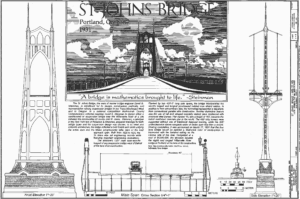PHOTO URL: https://commons.wikimedia.org/wiki/File:StJohnsBridgeHAER.png
Intro: 9th Grade High School World Social Studies. 2 weeks.
Content: This lesson will focus on:
- Understanding primary by interviewing a parent or guardian on their origin of their name.
- Direct engagement of the past which leads deeper context exploration, active analysis, and thoughtful response.
- Building community in the classroom and demonstrating a student centered approach.
Process: The lesson will consist of using WordPress, Haiku Deck, and Microsoft Word. Students will be researching the meaning and origin of their name by using a handout that I will provide. They will research and interview their parent or guardian as individuals. After presenting I Am Poem or Haiku Deck student must upload product on WordPress. Once upload is completed students will respond to two other classmates’ post. This will be a in class and homework assignment. Students will have chrome books available to them through Open School.
Product: Students worksheet, Haiku or I Am poem, presentation, and responses.
Evaluation: Students will be evaluated by participation and proficiency grading rubric. Goal of the activity to be a first win for students.
What kinds of thinking will students need to do to participate in the lesson? Students will be using higher order thinking in this lesson. I want students to connect their name with history to make this assignment meaningful.
To what extent do students have options or choices regarding these lesson components? Students will get to choose from two project that they will present I class. Students will have the chance to choose who they want to respond to.
Response: I haven’t gotten the chance to write a lesson plan before because of the program (OMAT) that I am. So this was a great exercise for me to experience. I enjoyed the challenge and reading my peers lesson study. I was inspired by Mrs. G, OPEN East social studies teacher, who created this lesson. Her intention in all her of the assignments and lessons are student centered and community centered. She did this project in hoped to inspire students finding pride in their name, and a way to get to know each other through poetry. Instead of writing it on a piece of paper and turning it in, I added either the option of the Haiku Deck or posted a written version online. Understanding the origin and history of our names is a great gateway to making history more relatable to students, because then they feel that their name holds value and it’s a piece of history.




